#United Nations Public Service Award
Text
Showcase the vital role of public service innovation in promoting sustainable development and inclusion.

In the last 20 years, the United Nations Public Service Awards Programme has recognized 500+ global initiatives showcasing the vital role of public service innovation in promoting sustainable development and inclusion.
#public servants#public service#united nations public service award#innovation#Globalgoals#sdgs#sustainable development
0 notes
Text
youtube
#youtube#news#State Department#Hunger Relief#Global Development#Antony Blinken#World Food Prize Laureate#Global Hunger#Secretary of State#International Relations#Food Security#United States#Leadership#Diplomacy#Foreign Affairs#Agriculture#Humanitarian Award#Government#Public Service#Global Issues#Announcement#Award Ceremony#Human Rights#Hunger Crisis#Secretary of State Blinken#Humanitarian Aid#United Nations#Development Goals#World Hunger#Speech
0 notes
Text
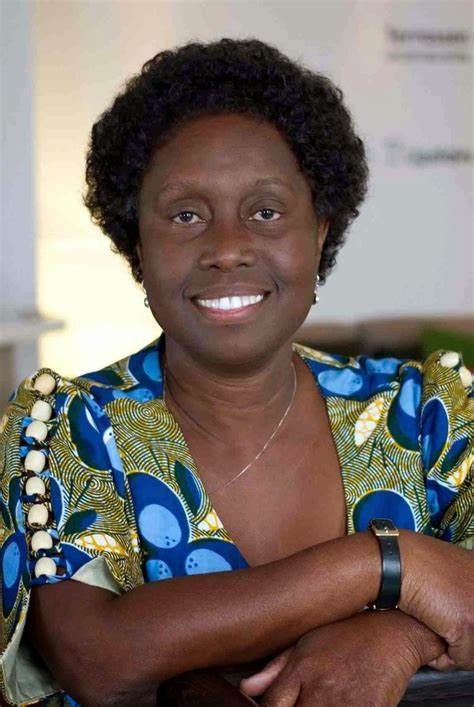

Notable Women In Zoology: Dr. Letitia Eva Takyibea Obeng
Dr. Obeng (1925-2023) was the first Ghanaian woman to obtain a degree in zoology, and the first to be awarded a doctorate. She is described as "the grandmother of female scientists in Ghana".
Her other notable accomplishments include:
A Bachelor of Science in Zoology and Botany (1952), a Master of Science in Parasitology (1962) and a PhD in Tropical Medicine (1964) where she studied the black fly and its relevance to river blindness
Post university, she lectured at the University College of Science and Technology (now known as Kwame Nkrumah University of Science and Technology, KNUST) from 1952 to 1959
In 1952, Dr. Obeng became the first female scientist at KNUST
After her husband's death in 19659, she moved to the the Council for Scientific and Industrial Research (CSIR)
IN 1964, she established the Institute of Aquatic Biology within CSIR to research the huge manmade Volta Lake in Ghana and its inland water system
Dr. Obeng was the first scientist to be employed by the National Research Council of Ghana
In 1965, Dr Obeng became a fellow of the Ghana Academy of Arts and Sciences. In 2006, she became the first female president of the Academy
In 1972, Dr. Obeng delivered the Caroline Haslett Memorial Lecture to the Royal Society for the Encouragement of Arts, Manufactures and Commerce, titled “Nation Building and the African Woman”
In 1972, she was an invited participant in the United Nations Human Environment Conference in Stockholm
In 1974, she began work as the Officer in the United Nations Environment Programme (UNEP), and in 1989, she became the Director of the UNEP Regional Office for Africa, and the UNEP's Representative to Africa
From 1992 to 1993, Obeng was a Distinguished International Visitor fellow at Radcliff College
In 1997, she received the CSIR Award for Distinguished Career and Service to Science and Technology, the first woman to receive such an award
The CSIR Laboratory (known as The Letitia Obeng Block) was named after her in 1997 as well
She received Ghana's highest national award, Order of the Star of Ghana in 2006
In 2017, she received an honorary Doctor of Science degree from KNUST
She was also the author of numerous publications and works. Two meant for the public were Parasites, the Sly and Sneaky Enemies inside You (1997) and -Anthology of a Lifetime (2019)
164 notes
·
View notes
Text

Today In History
Muhammad Ali was born on January 17, 1942, in Louisville, Kentucky. His birth name was Cassius Marcellus Clay Jr.
At an early age, young Clay showed that he wasn’t afraid of any bout—inside or outside of the ring.
At the age of 12, Clay discovered his talent for boxing through an odd twist of fate. After his bike was stolen, Clay told police officer Joe Martin that he wanted to beat up the thief. “Well, you better learn how to fight before you start challenging people,” said Martin.
Clay started working with Martin to learn how to spar and soon began his boxing career. In his first amateur bout in 1954, he won the fight by split decision. Clay went on to win the 1956 Golden Gloves tournament for novices in the light heavyweight class. Three years later, he won the National Golden Gloves Tournament of Champions, as well as the Amateur Athletic Union’s national title for the light heavyweight division.
In 1960, Clay won a spot on the U.S. Olympic boxing team and traveled to Rome to compete. After winning his first three bouts, Clay defeated Zbigniew Pietrzkowski of Poland to win the light heavyweight Olympic gold medal.
After his Olympic victory, Clay was heralded as an American hero. He soon turned professional and continued overwhelming all opponents in the ring. In 1964 Clay’s victory over Liston earned him his first world heavyweight boxing championship.
The next morning, on February 26, Clay announced his affiliation with the Nation of Islam, and his name became Muhammad Ali.
Muhammad Ali started a different kind of fight with his outspoken views against the Vietnam War, and in his retirement, Ali devoted his time to philanthropy around the world. In 1998 he was the United Nations Messenger of Peace, and in 2005 Ali received the Presidential Medal of Honor.
Ali also received the President’s Award from the NAACP in 2009 for his public service efforts.
“Truly great people in history never wanted to be great for themselves.” - Muhammad Ali
CARTER Magazine
#carter magazine#carter#historyandhiphop365#wherehistoryandhiphopmeet#history#cartermagazine#today in history#staywoke#blackhistory#blackhistorymonth#muhammad ali
122 notes
·
View notes
Text
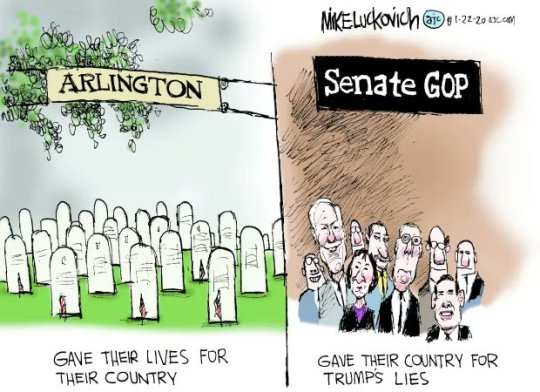
[Mike Luckovich]
* * * *
"An idea unlike any other."
May 28, 2024
ROBERT B. HUBBELL
On Memorial Day, President Biden hosted a breakfast for military leaders, veterans, and Gold Star family members. The event was closed to the press, so there are no photos or media reports of his remarks. Rather than turn a White House reception honoring fallen soldiers into a public event or campaign opportunity, the President met privately to express gratitude to soldiers and their families.
Later in the day, the President participated in the Wreath-Laying Ceremony at the Tomb of the Unknown Soldier at Arlington National Cemetery and then delivered the Memorial Day Address the Memorial Amphitheater.
In his remarks, President Biden said,
America is the only country in the world founded on an idea — an idea that all people are created equal and deserve to be treated equally throughout their lives.
We’ve never fully lived up to that, but we’ve never, ever, ever walked away from it. Every generation, our fallen heroes have brought us closer.
President Biden also issued a statement commemorating Memorial Day, writing (in part):
Since America's founding, our service members have laid down their lives for an idea unlike any other: the idea of the United States.
Today, as generations of heroes lie in eternal peace, we live by the light of liberty they kept burning.
May God bless them, always.
Joe Biden’s presence in the Oval Office elevates us as a nation. We are fortunate to have him as our president during this challenging time in our nation’s history.
Defendant Donald Trump issued his own statement commemorating Memorial Day. Trump posted a statement that began as follows:
Happy Memorial Day to All, including the Human Scum that is working so hard to destroy our Once Great Country, & to the Radical Left, Trump Hating Federal Judge in New York that presided over, get this, TWO separate trials, that awarded a woman, who I never met before (a quick handshake at a celebrity event, 25 years ago, doesn’t count!), 91 MILLION DOLLARS for “DEFAMATION” . . . .
What is notable about Trump's Memorial Day greeting is that it does not mention veterans—living or dead—but is instead devoted entirely to himself. In contrast, President Biden’s message mentions only those veterans who gave their lives for “the idea of America” and does not mention himself.
The same contrast is seen in President Biden’s private meeting with Gold Star families. Trump took a group photo with Gold Star family members at the Coca-Cola 600 while wearing a “MAGA” hat and giving a “thumbs up.” Photo Trump at NASCAR Event.
Trump also used Memorial Day Weekend to announce the creation of “Veterans and Military Families for Trump,” an announcement that included the following statement:
Unlike the weak Joe Biden, President Trump has consistently proven he cares deeply about the unbelievable sacrifices made by our nation’s Veterans and their wonderful families.
In short, Trump's relationship with veterans and Gold Star families is transactional, like everything else in his life: Fallen soldiers and veterans are props for his campaign. They matter only because they are part of a campaign organization supporting Trump.
The saddest part of that transaction is that the veterans’ sacrifices and their families’ grief are being exploited by a man who has called fallen veterans “suckers and losers.”
Rarely has our nation faced such a stark choice. On this Memorial Day, that choice is viewed through the lens of the sacrifice of more than a million Americans who died defending the “idea of America.” As President Biden said in his remarks today, we have “never fully lived up to the promise” of that idea. We cannot allow our past failures and present challenges to discourage us.
The question of whether a million Americans died in vain is for us to answer. They kept their oath; we must finish the story of their sacrifice. In 2024, we must honor America’s fallen veterans by ensuring that their sacrifice was not in vain by defending the democracy for which they gave their lives.
[Robert B. Hubbell Newsletter]
#Robert B. Hubbell#Robert B. Hubbell Newsletter#veterans#Memorial Day#compare and contrast#democracy#the Idea of America
19 notes
·
View notes
Photo
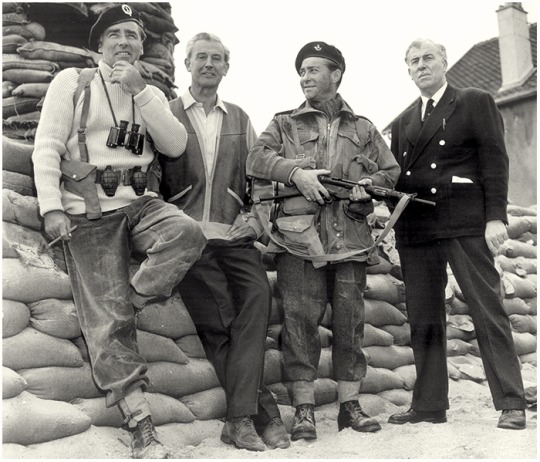
I never admitted to anybody during my entire military service that I had been an actor. I was terrified that I would be put in charge of Ensa [Entertainments' National Service Association]. Not even my closest friends knew I was an actor. I told them I was reading English at St Andrews University.
- Richard Todd
In his heyday in the 1950s and 1960s, Richard Todd was Britain’s leading matinee idol. If you love old movies, you’ll have seen Todd in one of his starring roles in “The Virgin Queen” opposite Bette Davis, “Stage Struck” with Marlene Dietrich, or “The Dam Busters” for which he won a Golden Globe Award. He was the tough little Scotsman in the wartime weepie “The Hasty Heart” and had audiences madly hunting for hankies.
Those were the days when Todd streaked across North American film screens as virtually every romantic hero from Rob Roy to Robin Hood. Ian Fleming chose him to play James Bond in “Dr. No” in 1962, but a schedule clash meant Sean Connery stepped into the role.
Little less known is the fact that he was also among the first British soldiers and the first Irishman to land in Normandy on D Day. More specifically, he participated in Operation Tonga during the D-Day landings in Normandy on 6 June 1944.
So it must have been surreal for Richard Todd the hearthrob actor to find himself playing Major John Howard in the epic movie ‘The Longest Day’ (1962) based on Cornelius Ryan’s book. Not least because he served with Howard and took part in the fighting at Pegasus Bridge that Major John Howard was tasked to secure on D Day.

Richard Todd was born in Dublin, Ireland, in 1919. His father was a medic in the British Army and, as his posting required, the early years of his life were spent in India. The family settled in Devon upon their return to England, and Richard was educated at Shrewsbury Public School, in Shropshire. The theatre was his first love, and he furthered his dramatic skills at the Italia Conti school, thereafter moving to Scotland where he helped to form the Dundee Repertory Theatre.
When War was declared, Todd went to St. Andrew's University on the following day to volunteer. He was not a member of the University, but he not only convinced the selection unit that he was, but also added that he had been reading English there for six months, and that he had obtained a Cert A in his school cadet corps; a key point to being accepted as an officer. Despite success in passing off this invented career, Todd was to be disappointed by a lack of interest in him thereafter.

Becoming increasingly desperate to get into the War before it ended, he sent numerous letters to the War Office to press his case, which, in June 1940, was finally noticed.
Accepted by the King's Own Yorkshire Light Infantry, Todd went to Sandhurst to receive his officer training. He had a very lucky escape here when he was in a corridor on the second floor of a building when it was hit by a bomb, and he was blown into the garden outside by the blast. He got to his feet in the darkness and did not feel particularly affected by it, but an examination by torchlight revealed that his whole body was covered in blood from numerous small wounds.
A spell his hospital delayed his passing out from Sandhurst until early 1941. Celebrating in London, he narrowly avoided death again when he found his usual haunt, the Cafe de Paris, was too crowded to admit him and so he went elsewhere; it was hit by a bomb that same night and 84 people were killed.
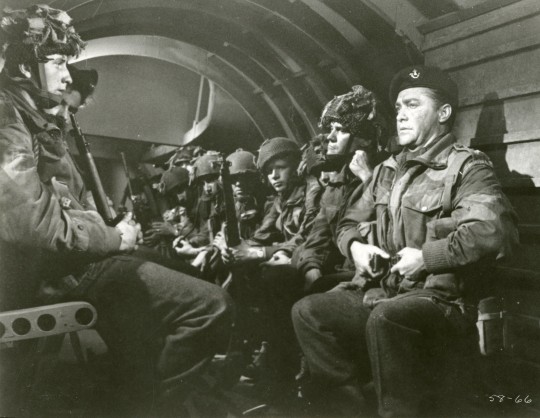
His Battalion, the 2nd/4th Battalion The King's Own Yorkshire Light Infantry, was posted to XII Corps in defence of Kent, where a German invasion if it came would almost certainly land. Todd was given command of the infantry in the Dymchurch Redoubt, a fort of the Napoleonic era mounting two six-inch guns.
In the event of an invasion, this would certainly have been a primary target for the enemy, and those manning it were told that, with the main defensive line far to their rear, they would be left to fight to the end. General Montgomery commanded XII Corps at this time, and his characteristic emphasis on training and preparedness led to the formation of the first Battle Schools. Richard Todd attended one of these, and the experience allowed him to run his own School when, in December 1941, he was sent to Iceland with the 1st/4th King's Own Light Infantry to be trained in arctic and mountain warfare.
Returning to England in September 1942, he eventually ended up in the 7th (Light Infantry) Parachute Battalion of the 6th Airborne Division. He was among troops of the 7th (Light Infantry) Parachute Battalion who, at 00:40 hours on 6 June 1944, landed behind the Normandy beaches in a cornfield, perilously close to tracer fire.
Todd scrambled into a wood and with 150 other paratroopers reached Pegasus and Ranville bridges, vital crossings to allow Allied forces to break out from the beachheads into Normandy. They had been seized by a glider force from the Ox and Bucks Light Infantry under the command of Major John Howard, who needed reinforcements to fend off ferocious German attacks.
In his memoirs, Caught in the Act, Todd would write of the carnage, “There was no cessation in the Germans' probing with patrols and counter-attacks, some led by tanks, and the regimental aid post was overrun in the early hours. The wounded being tended there were all killed where they lay. There was sporadic enemy mortar and artillery fire we could do nothing about. One shell landed in a hedge near me, killing a couple of our men.”
Todd would go on and see action at the Battle of the Bulge and push into the Rhine into Germany. After VE day, his division returned to the UK for a few weeks, then was sent on counter-insurgency operations in Palestine. During this posting he was seriously injured when his Jeep overturned, breaking both shoulders and receiving a concussion. He returned to the UK to be demobilised in 1946.
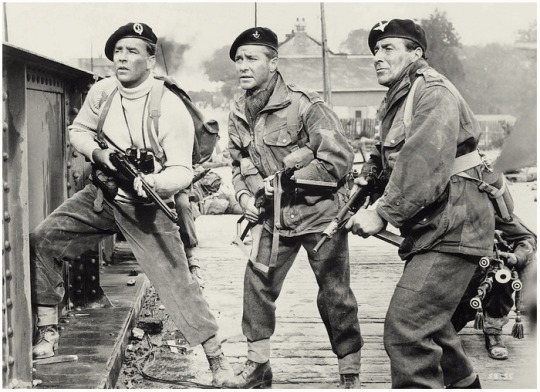
In 1962, Todd was given the part of Major John Howard in the film adaptation of Cornelius Ryan's book about the D-Day landings, ‘The Longest Day’ (1962). Due to the nature of cinema, it was impossible for the film to give a thorough reflection of the role of the 6th Airborne Division during the Invasion, and as such their activities were solely represented by a reconstruction of the capture of Bénouville Bridge by Howard's coup-de-main force. Although briefly mentioned, the role of the 7th Battalion in the defence of the western bridgehead was largely ignored, and so it appeared as if the defence of the bridge rested only on Howard's men.

Naturally, the omission of their fierce defence of Bénouville caused some resentment amongst veterans, not least because one of their own was championing this re-working of history. Todd, however, regarded ‘The Longest Day’ (1962) as a film rather than a documentary, and his part in it was simply that of an actor doing as he was told.
Richard Todd would never have guessed, that in 17 years since he was on Pegasus Bridge as a paratrooper that he would standing there again as an actor portraying Major John Howard who was given the order: 'Hold,… until relieved'. It had to be Richard Todd’s 'twilight-zone' moment.
The ‘relieve’ for Howard had to come from Lord Lovat and his troops, who had landed on SWORD Beach, and were legging it towards Pegasus Bridge.
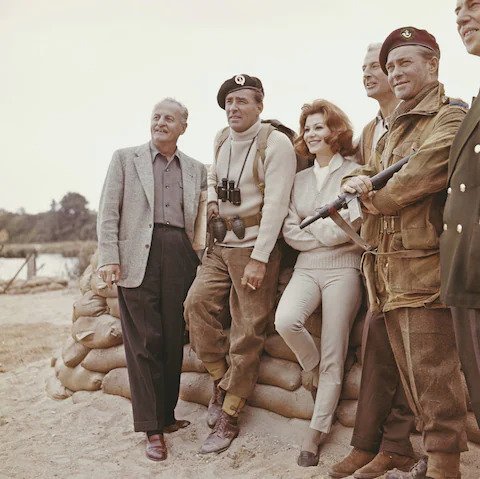
Before the shooting of the scenes were started at Pegasus Bridge, the film producer of The Longest Day, Darryl F. Zanuck, had the real life Lord Lovat and Major John Howard brought over to meet the men who were going to portray them (Peter Lawford portrayed Lord Lovat). The men had not seen each other since 6 June 1944.
Photo (above). From L-R: Peter Lawford, Lord Lovat, Richard Todd, Major John Howard.
#todd#richard todd#quote#british army#D Day#DDay#Normandy#pegasus bridge#war#second world war#major john howard#parachute#battle#actor#soldier#paratrooper#the longest day#film#movie#cinema#britain
113 notes
·
View notes
Text
The discovery that general paresis was caused by a bacterial microorganism and could be cured with penicillin reinforced the view that biological causes and cures might be discovered for other mental disorders. The rapid and enthusiastic adoption of electroconvulsive therapy (ECT), lobotomy, and insulin coma therapy in the 1930s and 1940s encouraged hopes that mental disorders could be cured with somatic therapies. Psychiatry's psychopharmacological revolution began in the 1950s, a decade that witnessed the serendipitous discovery of compounds that reduced the symptoms of psychosis, depression, mania, anxiety, and hyperactivity. Chemical imbalance theories of mental disorder soon followed (e.g., Schilkraudt, 1965; van Rossum, 1967), providing the scientific basis for psychiatric medications as possessing magic bullet qualities by targeting the presumed pathophysiology of mental disorder. Despite these promising developments, psychiatry found itself under attack from both internal and external forces. The field remained divided between biological psychiatrists and Freudians who rejected the biomedical model. Critics such as R. D. Laing (1960) and Thomas Szasz (1961) incited an “anti-psychiatry” movement that publicly threatened the profession's credibility. Oscar-winning film One Flew Over the Cuckoo's Nest (Douglas & Zaentz, 1975) reinforced perceptions of psychiatric treatments as barbaric and ineffective.
In response to these threats to its status as a legitimate branch of scientific medicine, organized psychiatry embraced the biomedical model. [...] The publication of the DSM-III in 1980 was heralded by the APA as a monumental scientific achievement, although in truth the DSM-III's primary advancement was not enhanced validity but improved interrater reliability. Psychiatrist Gerald Klerman [...] remarked that the DSM-III “represents a reaffirmation on the part of American psychiatry to its medical identity and its commitment to scientific medicine” (p. 539, 1984). Shortly after publication of the DSM-III, the APA launched a marketing campaign to promote the biomedical model in the popular press (Whitaker, 2010a). Psychiatry benefitted from the perception that, like other medical disciplines, it too had its own valid diseases and effective disease-specific remedies. The APA established a division of publications and marketing, as well as its own press, and trained a nationwide roster of experts who could promote the biomedical model in the popular media (Sabshin, 1981, 1988). The APA held media conferences, placed public service spots on television and spokespersons on prominent television shows, and bestowed awards to journalists who penned favorable stories. Popular press articles began to describe a scientific revolution in psychiatry that held the promise of curing mental disorder. [...]
United by their mutual interests in promotion of the biomedical model and pharmacological treatment, psychiatry joined forces with the pharmaceutical industry. A policy change by the APA in 1980 allowed drug companies to sponsor “scientific” talks, for a fee, at its annual conference (Whitaker, 2010a). Within the span of several years, the organization's revenues had doubled, and the APA began working together with drug companies on medical education, media outreach, congressional lobbying, and other endeavors. Under the direction of biological psychiatrists from the APA, the NIMH took up the biomedical model mantle and began systematically directing grant funding toward biomedical research while withdrawing support for alternative approaches like Loren Mosher's promising community-based, primarily psychosocial treatment program for schizophrenia (Bola & Mosher, 2003). The National Alliance on Mental Illness (NAMI), a powerful patient advocacy group dedicated to reducing mental health stigma by blaming mental disorder on brain disease instead of poor parenting, forged close ties with the APA, NIMH, and the drug industry. Connected by their complementary motives for promoting the biomedical model, the APA, NIMH, NAMI, and the pharmaceutical industry helped solidify the “biologically-based brain disease” concept of mental disorder in American culture. Whitaker (2010a) described the situation thus:
In short, a powerful quartet of voices came together during the 1980s eager to inform the public that mental disorders were brain diseases. Pharmaceutical companies provided the financial muscle. The APA and psychiatrists at top medical schools conferred intellectual legitimacy upon the enterprise. The NIMH put the government's stamp of approval on the story. NAMI provided moral authority. This was a coalition that could convince American society of almost anything… (p. 280).
–Brett J. Deacon, "The biomedical model of mental disorder: A critical analysis of its validity, utility, and effects on psychotherapy research." Clinical Psychology Review 33 (2013), 846–861. http://dx.doi.org/10.1016/j.cpr.2012.09.007
70 notes
·
View notes
Text
In honor of Black History Month, here are 10 Black Americans who were pioneers of their time. (I apologize that this post is late. I’ve been preoccupied with midterm exams)
Eugene Bullard (1895 - 1961)
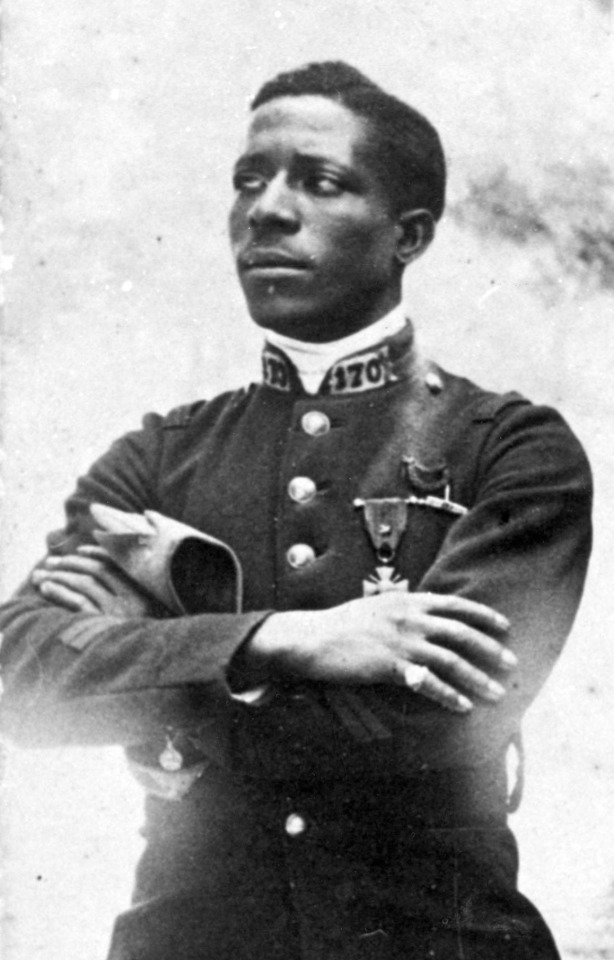
Eugene Bullard was one of the first African American military pilots in the world. Originally from Georgia, Bullard had run away from home when he was 11 and wondered around the state for six years with a clan of gypsies before stowing away on a German cargo ship in 1912. He ended up in Aberdeen, Scotland and eventually ended up in London, where he worked as a boxer and performer for an entertainment troupe. He traveled to Paris for a boxing match and eventually settled there permanently. When World War 1 began in 1914, Bullard joined the French Foreign Legion, where he saw combat at the Somme, Champaign, and Verdun. After being injured during the Battle of Verdun, he was sent to Lyon to recuperate. After recovering in 1916 he joined the French Air Service as a machine gunner. He obtained his pilot's license in 1917. He flew several missions during the war and claimed two victories over German planes. He applied to join the American Air Corps after the United States entered the war in 1917 but was rejected because of his race. Bullard returned to the French Air Service but was removed after an apparent conflict with a French officer. He remained in the military until 1919. He returned to Paris where he worked a nightclub, operated his own nightclub and gym, and married Marcelle de Straumann. After Germany invaded France in 1940, he volunteered to fight again, but was injured during the defense of Orleans. He escaped to Spain and later returned to the United States, settling in Harlem, New York City. In 1949, he was working as a security guard at concert hosted by Paul Robeson. Riots broke out where a racist mob and police officers beat concert goers, including Bullard. He eventually died of Stomach Cancer in 1961.
Bullard received many honors from France. In 1954, the French government invited Bullard to Paris to be one of the three men chosen to rekindle the everlasting flame at the Tomb of the Unkown Soldier under the Arc de Triomphe. In 1959, he was made a Knight of the National Order of the Legion of Honor. He also received the Military Medal, an award given for courageous acts and the third highest award in France. After his death, he also received honors from the United States. He was posthumously commissioned as a Second Lieutenant in the United States Air Force in 1994. He was inducted into the Georgia Aviation Hall of Fame in 1989 and the National Aviation Hall of Fame in 2022. The Museum of Aviation in Warner Robbins, Georgia erected a statute in honor of Bullard.
Ruby Bridges (1954 - )

Ruby Bridges hadn't even been born yet when, in 1954, the United States Supreme Court made a landmark ruling in the Board vs. Board of Education case that declared that desegregation in public schools was unconstitutional. This decision caused protests and celebrations all across the South, including New Orleans, Louisiana. In 1960, when Ruby was 6 years old, U.S. Circuit Court Judge ruled that schools in New Orleans must begin desegregation. Ruby was one of four 6-year-old girls (the others being Lenona Tate, Tessie Provost, and Gail Etienne) selected by the NAACP to participate in the integration. Tate, Provost, and Etienne enrolled at McDonogh 19 Elementary School, while Bridges enrolled at William Frantz Elementary School. All four faced death threats, racial slurs, and taunts. After a race riot broke out at Parish School Board meeting, U.S. Marshalls were called in to escort the girls to and from school.
Since the tumultuous period, Bridges has become a symbol of the Civil Rights Movement. She has been the subject of Songs, documentaries, movies, and 1964 Norman Rockwell painting "The Problem We All Live With". She is currently the Chair of the Ruby Bridges Foundation. She has also received numerous accolades over her life including the Presidential Citizens Medal by President Clinton in 2001, being honored as a "Hero Against Racism" by the Anti-Defamation League in 2006 and being inducted in the National Women's Hall of Fame in 2024.
Bessie Coleman (1892 - 1926)

Bessie Coleman was born the tenth child out of thirteen to a family of sharecroppers in Texas. She walked four miles each day to attend a segregated school where she loved reading and established herself as an exceptional math student. Every harvest season she helped her family harvest cotton. When was turned eighteen years old, she enrolled at the Oklahoma Colored Agricultural and Normal University in Langston, Oklahoma (known today as Langston University). She only completed one term before running out of funds and returning home. In 1915, she moved to Chicago to live with brothers where she worked as a manicurist at a barbershop, where she heard flying stories of pilots returning from their service in World War 1. She took a second job as a restaurant manager to save money in the hopes of becoming a pilot herself, but flight schools in the U.S. at the time were not accepting women nor black people. As such, she was encouraged to study abroad by Robert Abbott, publisher of the African American newspaper 'The Chicago Defender'. To do this she received financial backing from the defender and banker Jesse Binga (founder of the first black owned bank in Chicago).
In 1920, she traveled to France to earn her license. She trained on a Nieuport 14 Biplane. In 1921, she received her pilots license, becoming the first black woman (and first black person in general) to receive a license from the Fédération Aéronautique Internationale. She returned to the United States in September becoming a media sensation. She made a living performing in air shows as a stunt flier. She met with community activists and spoke before crowds about perusing aviation as a profession and the goals of black people in the United States. Unfortunately, she was killed in 1926, when the plane she was flying in lost control and threw her out at 2,000ft. Though she never established her own flight school, her ambitions inspired many other black aviators to this very day.
Katherine Johnson (1918 - 2020)
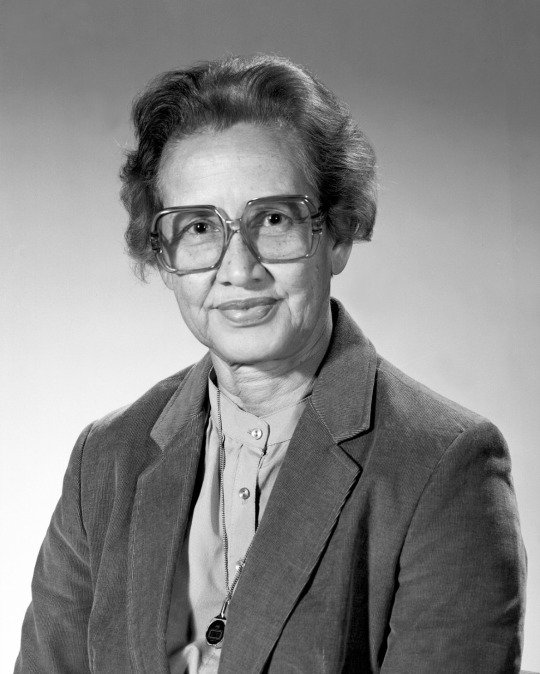
Katherine Johnson was one of the first black to be employed as a scientist at the National Aeronautics and Space Administration. Born in White Sulpher Springs, West Virginia, she was the youngest of four children. Her mother was a teacher, and her father was a lumberjack, farmer, and handyman. From an early age she displayed strong mathematical abilities, so her parents enrolled her in high school in Institute since their home county didn't school for African Americans passed the 8th grade. After graduating high school, she enrolled at West Virginia State College, where took every mathematics course offered (new classes were even added just for her). She graduated 'summa cum laude' in 1937 and took a teaching job Marion, Virginia.
In 1938, the Supreme Court ruled that states that provide higher education for white students must provide it for black students as well. As a result of this, Johnson was selected along with two men to become the first black students to be enrolled at the West Virginia University Graduate School in 1939. However, she left the program to start a family with her husband James Goble. The couple had three daughters: Joylette, Katherine, and Constance.
At a family gathering in 1952, a relative informed her that the National Advisory Committee for Aeronautics (NACA, the precursor to NASA) was hiring mathematicians and that the Langley Research Center was hiring Black applicants as well as white. Johnson took a job at the agency in 1953. She spent 33 years with NACA and NASA, where she earned a reputation as a human computer for mastering complex mathematical calculations and helping pioneer the use of electronic computers. She worked at topics including gust alleviation, flight trajectories, and launch windows. Her work was instrumental to the Apollo Missions during the Cold War 'Space Race'. For her work she was awarded the Presidential Medal of Freedom in 2015, the Silver Snoopy Award and a NASA Group Achievement Award in 2016, and the Congressional Gold Medal in 2019. She was the one of the subjects of the 2016 film Hidden Figures, and she was posthumously inducted into the National Womens Hall of Fame in 2021.
Shirley Chisholm (1924 - 2005)

Shirley Chisholm was the first black woman to be elected to the United States Congress. She was born in Brooklyn to working class parents. Since her mother face difficulty working and raising her children, Shirley and her three younger sisters were to live with their grandmother in Barbados. She said about her grandmother "Granny gave me strength, dignity, and love. I learned from an early age that I was somebody. I didn't need the black revolution to teach me that". She returned to the United States in 1934 and in 1939, began attending the integrated Girl's High School in Brooklyn. She did so well academically, she served as the Vice President of the Junior Arista Honor Society. She attended Brooklyn College where she majored in sociology and graduated in 1946. She married her husband Conrad in 1949. After suffering two miscarriages, the couple learned they could not have children. She worked as a teacher's aide from 1946 to 1953, during which she went on to obtain her master's degree in childhood education from Columbia University in 1951. She soon became an authority on childhood education and child welfare as a consultant for the Division of Day Care in New York City's Bureau of Child Welfare.
She entered politics when she joined the effort to elect Lewis Flagg Jr. to the bench as the first black judge in Brooklyn. The election group became known as the Bedford–Stuyvesant Political League (BSPL), which pushed candidates that supported civil rights and advocated for expanding opportunities in Brooklyn. After leaving the BSPL she worked with a number of different political groups including the League of Women Voters, the National Association for the Advancement of Colored People (NAACP), the Urban League, and the Democratic Party Club in Bedford-Stuyvesant, Brooklyn.
In 1964, Chisholm decided to run for the New York State Assembly after the present holder, Thomas R. Jones, was appointed to the New York City Civil Court. Despite resistance because she was a woman, she appealed to women voters and won the Democratic primary in June. She was elected in December serving in the assembly from 1965 to 1968, where she championed several pieces of legislation including expanding unemployment benefits and sponsoring the introduction of the SEEK program which helped disadvantaged kids enter college. In 1968 Chisholm ran for the United States House of Representatives for New Yorks 12th District, which had recently been redrawn to incorporate the Bedford-Stuyvesant neighborhood. She ran with the slogan "unbought and unbossed" and won the district with a nearly 2 to 1 margin over her opponent, becoming the first black woman ever elected to Congress. She served on a number of different committees during her career, including the Agriculture, Veterans, and Education and Labor Committees. She worked with Bob Dole to expand the Food Stamps program, played a critical role in the creation of the WIC program, and was a founding member of the Congressional Black Caucus and the National Women's Political Caucus. In 1972, she became the first black candidate for a major-party nomination for President of the United States and the first woman to run for the Democratic Party's presidential nomination, though she ultimately lost the nomination. She retired from politics in 1983, after 14 in Congress. She was posthumously awarded the Presidential Medal of Freedom in 2015.
Thurgood Marshall (1908 - 1993)

Thurgood Marshall was a lawyer and jurist who served as the black justice of the United States Supreme Court. Marshall was originally from Baltimore, Maryland, where graduated from high school with honors in 1925 and then attended Lincoln University in Pennsylvania where he graduated with honors in 1930 with a bachelor's degree in American literature and philosophy. While at Lincoln, he led the schools debate team to numerous victories. He attended Howard University Law School in Washington, D.C. because he couldn't attend the all-white University of Maryland Law School. While at Howard, he was mentored by NAACP first special counsel and Law School Dean George Hamilton Houston. He graduated first in class in 1933. He joined Houston as his assistant at the NAACP in 1935, where they worked together on the landmark case Missouri ex rel. Gaines vs. Canada, which ruled that any state which provides a school to white students had to provide in-state education to black students as well. After Houston returned to Washington, Marshall took over his position as special counsel to the NAACP and also became director-counsel of the NAACP Legal Defense and Educational Fund Inc.
During his career he argued 32 civil rights before the Supreme Court, winning 29 of them. Many of them were landmark cases including Smith vs. Allwright (which ruled that primary elections must be open to voters of all races), Morgan vs. Virginia (which ruled that a state law enforcing the segregation of interstate buses was unconstitutional), Shelley vs. Kramer (which ruled that racially restrictive housing covenants cannot be legally enforced), and Brown vs. Board of Education (which ruled that state laws requiring segregation in schools was unconstitutional).
In 1961, President John F. Kennedy appointed him as a judge on the United States Court of Appeals for the Second Circuit in order for Kennedy to demonstrate his commitment to the interests of black Americans. He took the oath after numerous delays by southern Senators. Marshall authored 98 majority opinions while on the bench. He was nominated as the United States Solicitor General by President Lyndon B. Johnson in 1965, where he won fourteen of the nineteen Supreme Court cases he argued. In 1967, Johnson nominated Marshall to be a Supreme Court Justice after Justice Tom C. Cark resigned. He took the Oath of Office on October 2. Marshall remained on the Court for 24 years until his retirement in 1991. A staunch liberal, he often dissented from the court as the liberal majority vanished and the court became more conservative. During his tenure he advocated for equal rights for minorities, opposed the death penalty, and supported abortion rights.
Jesse Owens (1913 - 1980)

Jesse Owens was an American track and field athlete who won four gold medals at the 1936 Summer Olympic Games. Owens was born the youngest of ten children in Oakville, Alabama. In 1922, his family moved to Ohio during the great migration in search of better opportunities. As a child, he developed a passion for running, which was encouraged by his middle school track coach Charles Riley. It was in middle school where he met Minnie Solomon. They married in 1935 and had three daughters: Gloria in 1932, Marlene in 1937, and Beverly in 1940. He first came to national attention while attending high school where he equaled the world record of 9.4 seconds in the 100 yards dash and long-jumped 24 feet 91⁄2 inches at the 1933 National High School Championship in Chicago. While a student at Ohio State University, Owens won a record eight NCAA championships. Notably in 1935, he set three world records and tied a fourth during the Big Ten Conference track meet in Ann Arbor. He equaled the world record of 9.4 seconds in the 100-yard dash and set records for the long jump at 26 feet 81⁄4 inches, the 220-yard sprint at 20.3 seconds, and the 220-yard low hurdles at 22.6 seconds, which cemented him in track and field history.
In 1936, in despite of his apprehension, he was selected to compete in the Summer Olympics in Berlin, Germany. At the time, Germany was under the iron grip of the Nazi regime led by Adolf Hitler. Hitler saw the games as an opportunity to promote the Nazi ideals of antisemitism and Aryan supremacy. He believed German athletes would dominate the games. However, he visions went unfulfilled. Over the length of competition Owens won Gold Medals in the 100-meter dash at 10.3 seconds, the long jump at 26 ft 5 inches, the 200-meter sprint at 20.7 seconds, and the 4 x 100-meter sprint relay at 39.8 seconds. On August 1, Hitler shook hands with the German victors only and left the stadium and then skipped all further medal presentations. Despite his victories, racial discrimination in the United States made it difficult for Owens to earn a living, being prohibited from appearing at sporting events and refused commercial sponsorships. He attempted several careers, but all they proved fruitless. He hit rock bottom in 1966, when he was prosecuted for tax evasion. In 1955, President Dwight D. Eisenhower selected Owens as a Goodwill Ambassador, being sent all around the world to promote physical exercise and tout American freedom and economic opportunity in the developing world, a position held until the 1970s. He also did product endorsement for corporations such as Quaker Oats, Sears and Roebuck, and Johnson & Johnson. He was invited to the 1972 Munich Summer Olympics as a guest of the West German government. He eventually retired and moved to Arizona with his wife. Owens succumbed to Lung Cancer in 1980 at the age of 66 and was buried in Tucson, Arizona. In 1983 he was inducted into the U.S. Olympic Hall of Fame and was posthumously a Congressional Gold Medal in 1990.
Hiram Revels (1827 - 1901)
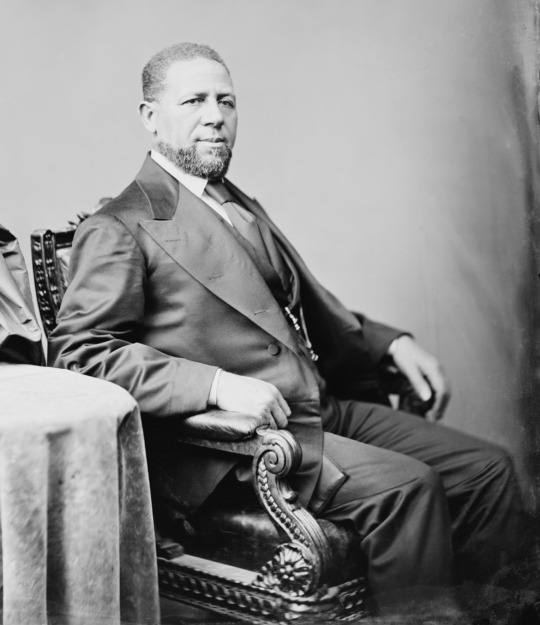
Hiram Revels was the first African-Amercian to serve in the United States Congress. He was born to free black people in Fayetteville, North Carolina. His father was a Baptist preacher. He attended a Quaker seminary in Indiana as a boy and in 1845, was ordained as a minister with the African Methodist Episcopal Church. He traveled throughout the Midwest preaching and acted as a religious teacher. He studied religion at Knox College in Illinois from 1855 to 1857 and then became a minister a Methodist Episcopal Church in Baltimore, Maryland, while also serving as a high school principal. During the Civil War, he enlisted as a Chaplain in the Union Army and helped recruit and organized two black regiments in Maryland and Missouri.
In 1866, Revels was called to be the pastor in Natchez, Mississippi where he settled permanently with his wife and five daughters. In 1868, during the Reconstruction Era, he was elected as an Alderman of Natchez and in 1869, he was elected to represent Adams County in the Mississippi State Legislature. In 1870, Revels was elected to the United States Senate by the state legislature to fill the seat left since before the Civil War. Southern Democrats opposed his seat, stating that the 1857 Dred Scott decision disqualified him on basis if citizenship. He officially became the first black senator on February 25. As a senator, he advocated compromise and moderation, and supported racial equality. He served on both the Committee of Education and Labor and the Committee of the District of Columbia (at the time, Congress administered the district). His professional conduct was greatly admired by fellow congressmen and the Northern press. After his term expired, he became President of Alcorn Agricultural and Mechanical College in Claiborne County, Mississippi (currently Alcorn State University). He served in this post until his retirement in 1882. In 2002, he was listed as one of 100 Greatest African Americans by Molefi Kete Asante.
Henry Johnson (1897 - 1929)
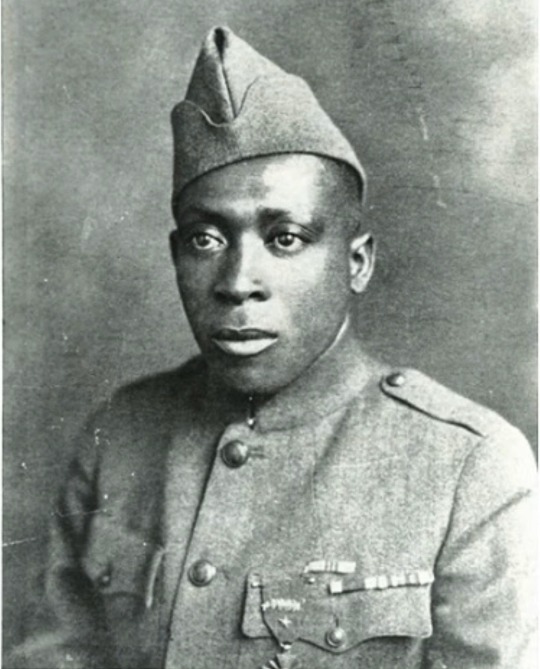
Henry Johnson was an American soldier who was noted for heroic actions during World War One. Originally from North Carolina, he moved to Albany, New York and worked variety of menial jobs before enlisting in the army in 1917, two months after the United States entry into the First World War. The unit he was assigned to, the all-black New York National Guard 15th Infantry Regiment, was mustered into federal service and redesignated as the 369th Infantry Regiment, commonly known as the Harlem Hellfighters. The regiment was assigned to labor service duties while stationed in Europe. The black service members faced discrimination and harassment by white soldiers and even the American headquarters. The American commander loaned the regiment to the French Army. It's believed he did this because white soldiers refused to fight alongside black soldiers. The French enthusiastically welcomed the new troops.
The regiment, Johnson included, was assigned to the Ardennes Forest. While on outpost duty on the night of May 14, 1918, Johnson came under attack by a German raiding party. Using only his bare hands, a bolo knife, his rifle butt, and some grenades, he was able to repel the attackers, killing four of them and preventing the capture of his fellow soldiers, all while suffering 21 wounds. He was given the nickname "Black Death" for his actions and awarded the Croix de guerre by France. However, his actions went unrecognized in the U.S. because of racial discrimination, and he died poor and in obscurity. However, he has since been posthumously given several awards by the military, including the Purple Heart in 1996, the Distinguished Service Cross in 2002, and the Medal of Honor in 2015. In 2023, the U.S. Army base Fort Polk in Louisiana was renamed Fort Johnson in his honor.
Dorothy Height (1912 - 2010)
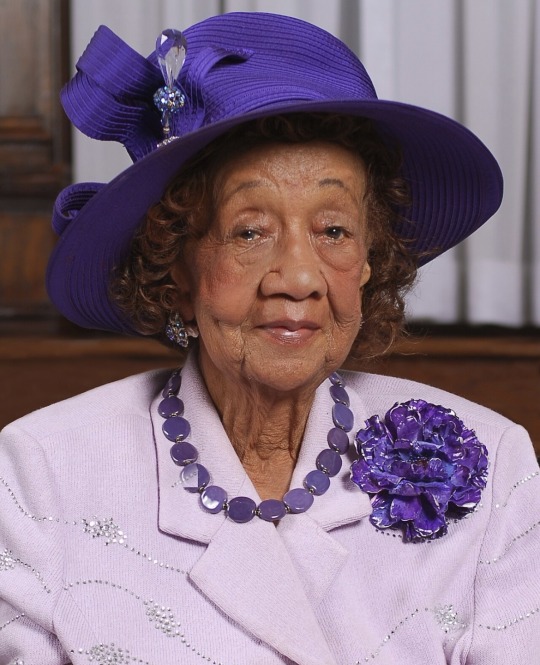
Dorothy Height was an activist for both the Civil Rights and Women's Rights movements. Height was born in Richmond, Virginia and moved to Rankin, Pennsylvania when she was five. Her mother was active in the Pennsylvania Federation of Colored Women's Clubs, and regularly took along Dororthy to meetings, which exposed her to activism from a young age. Height was an enthusiastic participate in Young Women's Christian Association, who was eventually elected as president of the club. She was appalled to learn that her race prevented her from using the YMWA's central branch swimming pool and dedicated much energy to changing the YWCA. While in high school she was active in the anti-lynching movement and won first place and a $1,000 scholarship in a national oratory contest held by the Elks Club. Height graduated from high school in 1929 and was accepted entry in Bernard College at Columbia University but was barred from entering because the school had an unwritten policy of only admitting two black students a year. She instead enrolled at New York University and graduated with a bachelor's degree in 1932 and a master's degree in educational psychology in 1933. She pursued postgraduate work at the New York School of Social Work.
From 1934 to 1937, Height worked for the New York Department of Welfare, a job she credited for teaching her conflict resolution skills. She then took a job as a counselor at the YWCA Harlem Branch. While working there she met civil rights activist Mary McLeod Bethune and First Lady Eleanor Roosevelt at a meeting of the National Council of Negro Women being held at the YWCA office. During this meeting Bethune told her "The freedom gates are half ajar. We must pry them fully open". She dedicated her life to this cause. She also did work with the United Christian Youth Movement, a group that worked to relate faith to real-world problems.
Beginning in 1939, she worked at YWCA offices in New York City and Washington, D.C., specializing in interracial relations. She ran trainings, wrote periodicals, and worked in Public Affairs on race issues. She believed that segregation caused prejudice through estrangement, so after the YWCA adopted in interracial charter in 1946, Height worked to help white members of the organization transcend their apprehension and bring their action in line with what the YWCA principles by running workshops, facilitating meetings, and writing articles. In 1958, she was elected president of the National Council of Negro Women and remained at the post until 1990. While president of the NCNW, she worked alongside civil rights leaders such as Martin Luther King Jr., John Lewis, and Whitney Young. Thanks to her background as an orator, she became a master at acting as the middleman in initiating dialogue between feuding parties. In 1963 she became head of the "Action Program for Integration and Desegregation of Community YWCAs", which was started in response to the growing civil rights movement. In this role she worked to monitor progress in integrating the association. In 1974, she was named to the National Commission for the Protection of Human Subjects of Biomedical and Behavioral Research, which was formed in response to the Tuskegee Syphilis Experiment scandal. She was also a driving force behind the movement to get a statue of Mary McLeod Bethune in Lincoln Park, the first statue of a woman or a black person to be erected on federal land.
She was inducted into the National Women's Hall of Fame in 1993. She was awarded the Presidential Citizen's Medal in 1989, the Presidential Medal of Freedom by President Bill Clinton in 1994, a Congressional Gold Medal by President George H.W. Bush in 2004, and President Barack Obama called Height "the godmother of the civil rights movement and a hero to so many Americans". She died on April 20, 2010, at the age of 98. She was buried at Fort Lincoln Cemetery in Maryland after a funeral at the National Cathedral in Washington D.C. She is considered one of the driving forces of the American Civil Rights Movement.
8 notes
·
View notes
Text


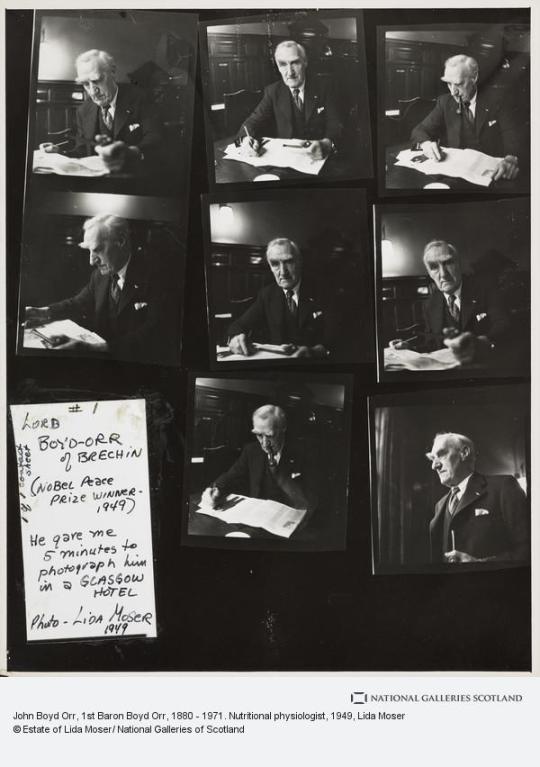
On June 25th 1971 , John Boyd Orr, biologist and Nobel Prize Winner, died.
John Boyd Orr's pioneering research led to millions of children across the UK being given free school milk from 1946 to 1971 when Margaret Thatcher, then education secretary, cut provision giving her the mick name Thatcher, "Thatcher, Thatcher, milk snatcher”
Boyd Orr was born in Ayrshire into a religious and highly literate family, and it was perhaps inevitable that he should be destined for a career in teaching after studying theology. However, his studies at Glasgow University also opened up new avenues for him. He became interested in the theories of Darwin, and this led to a fascination with zoology.
When he graduated with his MA in 1902, he was assigned to a teaching position in the Glasgow slums to fulfil the obligations required by his scholarship. He lasted only a few days before resigning and going back home to Ayrshire where he was reassigned to a school in Saltcoats. There he completed his teaching but left as soon as he could, saying: "though I liked the children, I hated teaching them”.
Boyd Orr returned to university to study biology and medicine, and he graduated with a BSc in 1910 and MB ChB two years later. He only practised for one month before returning to university to undertake nutritional research. His MD thesis in 1914 was awarded the Bellahouston Gold Medal for the most distinguished thesis of the year.
On the recommendation of his supervisor, he was asked to be the first director of a new research institute in Aberdeen, which would later become the world renowned Rowett Institute. At the time of his appointment, it did not exist, but he would spend the next twenty-five years raising both funds and the profile of nutritional research to make it a reality.
The initial work to build the institute was, however, interrupted by the outbreak of war. Boyd Orr enlisted in the RAMC and saw active service on the Western Front where he was awarded both the Military Cross and the Distinguished Service Order. Later he would never wear the medals saying that the truly brave men had all died.
In the interwar years, he travelled widely and published extensively, emerging as one of the country’s leading experts in nutrition. He first came to national attention in 1936 with the publication of Food, Health and Income, a report of a dietary survey by income group, which revealed that the cost of a diet meeting basic nutritional needs was beyond the means of half the British population.
This led to similar studies being conducted in nineteen other countries and prompted the creation of a Commission of the League of Nations, which tried to formulate a global food policy. It became the forerunner of the United Nations Food and Agriculture Organization (FAO). Boyd Orr would become the Director General of the FAO from 1945-48. These were important years because the predicted European post-war famine was averted in part by policies put forward by the organisation.
Boyd Orr was no stranger to the challenges of developing and implementing food policies, many of which are still with us today. He spent his later career trying to persuade governments and presidents, organisations and companies to rethink the way they did things. However, he would often bemoan the fact that while he could persuade farmers of the importance of the nutrition of their animals, he could not stir their interest “in the food of their ain bairns, far less in the bairns of ither folks”.
His was a life filled with honours and awards, from Gold medals at University to military decorations to honorary degrees and more. He was elected Rector of Glasgow University and subsequently became its Chancellor. He was briefly a British Member of Parliament, and in 1935 he was knighted for his services to agriculture. In 1949, after he was awarded the Nobel Prize, Prime Minister Clement Attlee ennobled him as Baron Boyd Orr of Brechin Mearns.
Reading of Boyd Orr’s long career it seems he had a series of false starts and perhaps even failures. But he was no dilettante. He combined a powerful intellect with an admirable work ethic to achieve a mastery in everything he tried. That he chose to move from a career in teaching to medical practice, to research, to politics and then to governance and policy making was not evidence of mere restlessness but of a constant desire to do meaningful work.
Boyd Orr was at heart a man with an ambitious vision for the world, and he firmly believed that real peace and prosperity would only ever be achieved when no one was hungry.
The citation for the 1949 Nobel Peace Prize read: “for his lifelong effort to conquer hunger and want, thereby helping to remove a major cause of military conflict and war”.
19 notes
·
View notes
Text


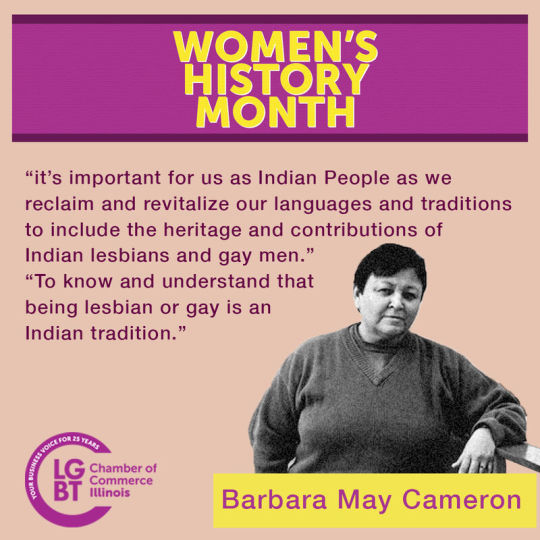
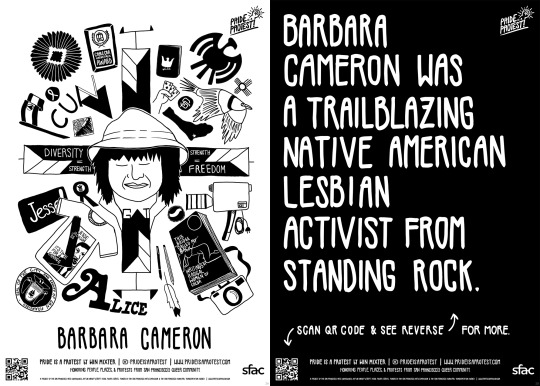
Barbara May Cameron's 69th Birthday May 22, 2023
Barbara May Cameron (May 22, 1954 – February 12, 2002) was a Native American photographer, poet, writer, and human rights activist in the fields of lesbian/gay rights, women's rights, and Native American rights.
Today’s Doodle celebrates Barbara May Cameron, a Native American photographer, poet, writer, and human rights activist. The Doodle artwork is illustrated by queer Mexican and Chitimachan artist Sienna Gonzales. On this day in 1954, Barbara Cameron was born in Fort Yates, North Dakota.
Cameron was born a member of the Hunkpapa group, one of the seven council fires of the Lakota tribe, and raised on the Standing Rock Reservation by her grandparents. After graduating high school, she studied photography and film at the American Indian Art Institute in Santa Fe, New Mexico. It was here that Cameron began winning awards in theater and media arts.
After coming out as a lesbian, Cameron moved to San Francisco in 1973 and advocated for LGBTQIA+ acceptance in the Native American community and addressed racism in queer spaces. In 1975, she co-founded Gay American Indians — the first ever dedicated Native American LGBTQIA+ group — with her friend and fellow activist Randy Burns.
Cameron took part in various programs to promote human welfare. From 1980 through 1985, she organized the Lesbian Gay Freedom Day Parade and Celebration. She also co-led a lawsuit against the Immigration & Naturalization Service which had a policy of turning away gay people. The case went before the Supreme Court and ruled in favor of Barbara and her co-plaintiffs who made persuasive arguments for change.
A few years later, she became an executive director at Community United Against Violence, where she supported people affected by hate crimes and domestic violence. The San Francisco Mayor appointed Cameron to both the Citizens Committee on Community Development and the San Francisco Human Rights Commission in 1988, and the next mayor appointed her to the United Nations Commission on the Status of Women.
HIV/AIDS disproportionately impacted Native people in the early 1990s, so Cameron stepped up to lead the charge. She was active within the San Francisco AIDS Foundation, the American Indian AIDS Institute, and served as a consultant to the U.S. Department of Health and Human Services and the Centers for Disease Control, helping with AIDS and childhood immunization programs.
Cameron is remembered for her passionate writing and speeches, many of which are housed at the San Francisco Public Library. Her words live on through her essay, No Apologies: A Lakota Lesbian Perspective which is featured in Our Right To Love: A Lesbian Resource Book.
Happy birthday Barbara May Cameron, thank you for working tirelessly to improve human rights and for giving queer Indigenous people a place to feel safe and belong.
Native American Standing Rock Sioux Tribe
Barbara May Cameron was a Hunkpapa Lakota from the Fort Yates band of the Standing Rock Sioux Tribe in Fort Yates, North Dakota. She grew up on the Standing Rock Indian Reservation, North Dakota, raised by her grandparents. Completing her early education and high schooling on the reservation, she went on to further her education in photography and film at the Institute of American Indian Arts in Santa Fe, New Mexico. In 1973 Cameron moved to San Francisco to attend the San Francisco Art Institute.
30 notes
·
View notes
Text
Institutional resilience and innovative responses to the COVID-19 pandemic.
Social Inclusion and Community Activation Programme - United Nations Public Service Award 2022 Winner.
#Ireland#Institutional resilience#Public Institutions#SDG16#SDG3#social inclusion#United Nations Public Service Award
0 notes
Text
𝕣𝕖𝕤𝕖𝕒𝕣𝕔𝕙 𝕡𝕣𝕠𝕛𝕖𝕔𝕥: 𝕓𝕦𝕣𝕖𝕒𝕦 𝕠𝕗 𝕚𝕟𝕕𝕚𝕒𝕟 𝕒𝕗𝕗𝕒𝕚𝕣𝕤

When the factory fur trade of North America was abolished in 1822, the US Government was left searching for a way to maintain control in Indian territories. John C. Calhoun, then Secretary of War, created the “Bureau of Indian Affairs (BIA)” on March 11, 1824. He did so without authorization from Congress, which is against the general practice although not expressly forbidden by the Constitution. John Calhoun would go on to become the Vice President of the United States the following year.
1825 was an interesting year in US history, representing the end of the Era of Good Feelings that followed the War of 1812. The presidential election would split the previous first party system into the Democrat and Republican system we now know today. The country was taking its first steps to limit the expansion of slavery into its newly aquired territories. As Jacksonian Democracy extended the privilege of voting to most white men aged 21 or older, removing the previous requirement to own land, racist and colonial mentalities spread in the form of “manifest destiny”. The US needed to remove Indian peoples from their homelands and they needed a way to do it.
The Bureau of Indian Affairs would go on to forcibly remove native peoples from their nations under the direction of Senator and then Secretary of State, John C. Calhoun. In the late 1800’s, after succeeding in removing many tribal nations from their homelands, the Bureau of Indian Affairs created the Residential Schooling system to assimilate Indian children into American culture. Missionaries had already established the practice, but the Bureau of Indian affairs built their schools specifically off-reservation and incorporated “students” from a variety of different tribes to aid in their goal of assimilation. Their model was the infamous Carlisle Indian Industrial School in Pennsylvania.
The 1960’s and 1970’s saw a rise in activism for and among American Indians. The Bureau faced a number of displays of public opposition by Indian people and those who supported them, like the 1972 Occupation of BIA Headquarters. Today, the Bureau of Indian Affairs is responsible for quite a few different things, all concerning the affairs of American Indian people on Tribal lands.
The Bureau as a whole is responsible for the federal recognition of tribes, most recently the Little Shell Tribe of Montana. The Office of Field Operations is responsible for regional operations, working with tribal governments on the management of natural resources, agriculture, fish and wildlife, and parks. The Office of Justice Services operates several programs and also provides funding for law enforcement, tribal courts, and detention facilities on federal lands. Their jurisdiction is surprisingly expansive, holding authority over all crimes committed on reservations and all federal crimes, as well as all crimes committed within “dependent Indian communities” or on trust lands. It is also the responsibility of the OJS to enforce tribal criminal codes and assist tribes in maintaining their courts and justice systems. They also operate the Indian Police Academy, where agents are trained to work specifically in Indian Country. The Office of Trust Services is responsible for overseeing land and resources that are recognized as tribal but owned in trust by the US federal government. Finally, the Office of Indian Services comprises a wide range of different programs, including social services and child welfare, transportation infrastructure, awarding federal funds to tribes, and providing resources to tribal governments. It is generally in their mission statement and enumerated responsibilities to uphold tribal sovereignty under the Indian Self Determination and Education Assistance Act.
Sources: x.x.x.
#history#anthropology#native american studies#bureau of indian affairs#natives in academia#native history#indigenous#studyblr#natives on tumblr#indigenous people#native americans#land back#american history#john c calhoun
76 notes
·
View notes
Text

Robert L. Woodson Sr. (born April 8, 1937) in South Philadelphia is described as the “godfather” of the movement to empower community-based organizations to help themselves. He rose from liberal-oriented neighborhood civil rights activism in the 1960s to coordinating national community development programs in the 1970s.
He headed the National Urban League’s Administration of Justice Division, the Neighborhood Revitalization Project, and had a fellowship with the American Enterprise Institute. He founded the National Center for Neighborhood Enterprise. The name was shortened to Center for Neighborhood Enterprise and he serves as its president. The program have helped more than two thousand six hundred community groups in thirty-nine states. CNE’s approach reduced gang wars and increased opportunities for resident ownership of former public housing units.
Independent evaluations credited these initiatives with significant reductions in school absences, incidents of violence, and police arrests. He has advised the 104th Congress, the Pennsylvania Legislature, and the Wisconsin Assembly on poverty and welfare reform.
One of five children, determined not to join a gang, he dropped out of high school and joined the Air Force. He earned his GED and enrolled in Cheyney State University, where he graduated with a BS in Mathematics. He earned an MSW from the University of Pennsylvania and holds honorary doctorates from Colorado Christian University and the University of Cincinnati. He has received a John D. and Catherine T. MacArthur “Genius” Fellowship and the Lynde and Harry Bradley Foundation Prize. He was awarded the Presidential Citizens Medal.
He has authored hundreds of articles on poverty and empowerment as well as several books, including A Summons to Life: Mediating Structures and the Prevention of Youth Crime. He sits on the boards of the American Association of Enterprise Zones, the Commission on National and Community Service, and the Commonwealth Foundation. He married Ellen (1977) and they have four children. #africanhistory365 #africanexcellence
2 notes
·
View notes
Text
The Russian Interior Ministry has put author and journalist Masha Gessen on its wanted list, according to Mediazona, who found the information in the ministry’s database.
The listing states that the basis for the warrant was “an article of the Criminal Code,” though it does not specify which one.
In late November, Dozhd reported that a criminal case had been opened against Gessen for spreading “fakes” about the Russian army. Ostensibly, the reason for the case was Gessen’s interview with journalist Yury Dud, which, among other things, discussed the crimes of the Russian army in Bucha.
Masha Gessen is known for being the former director of the Russian service of Radio Liberty. Their articles have appeared in The New York Times, The New Yorker, and other American publications. Gessen’s book, The Future is History. How Totalitarianism Reclaimed Russia won the 2017 National Book Award, one of the most prestigious literary awards in the United States.
2 notes
·
View notes
Text
Veterans’ Day is a National holiday that honors the men and women who have served in the United States Armed Forces. It keeps the importance of those who protect our homeland close to our hearts and reminds us of their bravery and valor. Native Americans have fought valiantly in the United States military in every conflict since the American Revolution, even before Native Americans gained U.S. citizenry in 1924. Honoring Native warriors and veterans has always been part of indigenous culture. It keeps the importance of those who protect our homeland close to our hearts and reminds us of their bravery and valor. Each year, in honor of Veterans Day, the Institute for American Indian Studies in Washington Connecticut honors the exceptional military service of Native Americans in a formal dedication. This year, the Institute is once again inviting the public to participate in the program that will honor Native and non-Native Americans whose passion and loyalty have helped to make America what it is today on Sunday, November 5 at 12:30 p.m. The Institute is located at 38 Curtis Road in Washington Connecticut. At this year’s event, veteran Gary Tinney, Paugussett, will lead the ceremony. New at this year’s event is the Yootay Singers Drum Group based out of Mashantucket, CT, which will perform honor songs recognizing the rich contributions of Native and Non-Native Americans who have bravely served side by side in the U.S. Armed Forces. Allan Madahbee (Ojibwe) will also join the ceremony and play Amazing Grace on his traditionally crafted flute. Attendees will be immersed in a meaningful ceremony that is a powerful experience. The ceremony will be outside so attendees are advised to dress appropriately for the weather. In the event of rain, the ceremony or portions of it will be held inside the museum. This event is free and open to the public, but pre-registration and donations are always appreciated. Registration is at http://iaismuseum.org. For questions please call (860) 868-0518 or email [email protected]. About The Institute for American Indian Studies (IAIS) Located on 15 woodland acres the IAIS preserves and educates through archeology, research, exhibitions, and programs. We have an outdoor replicated 16th c. Algonkian Village, the award-winning Wigwam Escape, and a Museum with temporary and permanent displays of authentic artifacts from prehistory to the present that allow visitors to foster a new understanding of the world and the history and culture of Native Americans. The Institute for American Indian Studies is at 38 Curtis Road in Washington Connecticut.
Veterans’ Day is a National holiday that honors the men and women who have served in the United States Armed Forces. It keeps the importance of those who protect our homeland close to our hearts and reminds us of their bravery and valor. Native Americans have fought valiantly in the United States military in every conflict since the American Revolution, even before Native Americans gained U.S.…
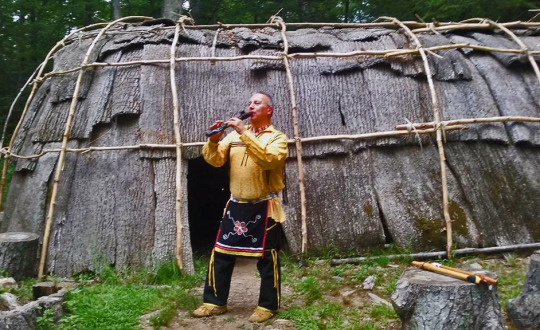
View On WordPress
#iaismuseum#iaismuseumct#veteransday veteransdayevents nativeAmericanveterans#Connecticut#CT event#CT events#Ct News#family fun#Litchfield Hills#New England#things to do in CT#Washington CT
2 notes
·
View notes
Text
NRO has Signed Historic Contracts with Several Commercial Satellite Service Providers
The US National Reconnaissance Office (NRO) recently announced that it has awarded contracts with a potential value of billions of dollars to Blacksky,Maxar and Planet three commercial satellite image data service providers. This action not only reflects the growing dependence of the US military and intelligence community on commercial data, but also indicates that commercial data may occupy half of the Geospatial Intelligence field of the US intelligence community in the next decade.
Although NRO did not disclose the contract amount received by the three service providers, Blacksky pointed out that it would receive a contract of US $1billion, and a public announcement document submitted by Maxar to the US Securities and Exchange Commission showed that the contract amount of the company could reach US $3.24 billion at most.
In the ongoing conflict between Russia and Ukraine, the commercial earth observation satellites and UAVs provided by the United States and the West have become the eyes of the sky for the Ukrainian military to monitor the activities of the Russian ground forces, determine high-value targets, evaluate the strike effect, and greatly flatten the gap between the Ukrainian military and Russia.
In addition, the US and Western news media, Bellingcat and other open-source intelligence analysis organizations also take the commercial satellite image data as the main basis for tracking the situation of the Russian Ukrainian battlefield and planning the anti Russian information war. In this context, three commercial satellite image service providers, Blacksky, Maxar and Planet, won a "historic" order with a potential value of billions of dollars, which will obviously stimulate more capital to flow into the new track of commercial space data services.
34 notes
·
View notes